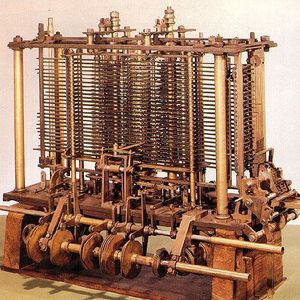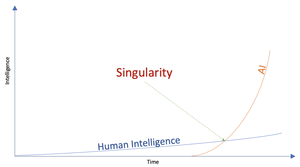Machines: Difference between revisions
No edit summary |
No edit summary |
||
| Line 9: | Line 9: | ||
When the first machines were created, their mechanisms were further refined as to increase their productive output. For instance, a drill press can have lubrication on its cogs to make it more efficient and easy to use. When a series of machines are placed into an enclosure this is called a ''factory''. | When the first machines were created, their mechanisms were further refined as to increase their productive output. For instance, a drill press can have lubrication on its cogs to make it more efficient and easy to use. When a series of machines are placed into an enclosure this is called a ''factory''. | ||
[[File:Difference engine.jpg|alt=Difference engine|thumb|Figure 2. The first computer. Babbage's 1882 Difference Engine.]] | [[File:Difference engine.jpg|alt=Difference engine|thumb|Figure 2. The first computer. Babbage's 1882 Difference Engine.]] | ||
This stepping up of complex systems is also comparable to the world of computers. The first computers | This stepping up of complex systems is also comparable to the world of computers. The first computers took their energy from manual cranking, which processed information into other kinds of information (productive output) via a function with cogs (Figure 2) with the externality being the CO2 in the crankers breath. Computer mechanisms were further refined in being powered by electricity and the cogs being replaced with virtual parts called algorithms. | ||
== Machine Intelligence == | == Machine Intelligence == | ||
Revision as of 01:23, 31 May 2022
A machine is a collection of enclosed parts that use energy to produce a desired function. This may be as simple as cogs in a drill press making holes in wood or employees working in a corporation to make profit.
The majority of machines use a source of energy (such as electricity) to make two products:
- A productive output called an internality such as holes in wood or profit in the bank.
- A waste output called an externality such as wood shavings or waste.
When the first machines were created, their mechanisms were further refined as to increase their productive output. For instance, a drill press can have lubrication on its cogs to make it more efficient and easy to use. When a series of machines are placed into an enclosure this is called a factory.
This stepping up of complex systems is also comparable to the world of computers. The first computers took their energy from manual cranking, which processed information into other kinds of information (productive output) via a function with cogs (Figure 2) with the externality being the CO2 in the crankers breath. Computer mechanisms were further refined in being powered by electricity and the cogs being replaced with virtual parts called algorithms.
Machine Intelligence
Hawkings[1], Musk[2], Gates[3], have all stated their fear of the potential existential threats we face with the development of AI. There are multiple reasons however it boils down to if you create something more intelligent than yourself it may find out some information which we do not know which might rationalise destroying human life. For instance, if an AI was tasked without hard written (ROM) specifying something along the lines of Issac Asimov's three laws of robotics to protect biodiverse life on earth its first thought would most probably kill the majority of humans. Luckily, as of yet no autonomous robots have been created in the traditional sense.
There are many problems with the creation of General AI, and many of them have been solved for instance human intelligence has been mimicked as a starting point, spawning neural networks and machine learning technology which has taught us that weighting masses of data points in an interlaced network of tables helps computers come up with better solutions to problems. However, as of yet, it seems not to have been able to unhook from coded heuristics to make its own about the world.
Noimosynthesis argues that corporations are an amalgamation of legal heuristics which has enabled the creation of state recognised entities which will prove to be the starting point of new AI systems. They already exist and since the creation of computers have been advancing through a singularity to become autonomous beings similar to DAOs.
The machines we fear are already here, means many share the same existential dread of super intelligent machines being our overlord. Machine theory argues the seeds of them already walk amongst us. The weakest part of these machines currently are the people, unionisation and strikes historically have been effective in jamming the machines progress, however with the further developments in robotics and self governing quality management systems means a cybernetic system is nearly upon us. We have a limited time now as humans still have power to clog the machines progress into something autonomously run in the pursuit of profit. Unfortunately, the longer we do not take action, the quicker the process becomes.
This is occuring not because of villainous masterminds concocting an evil plan for world domination, it is an emergent phenomenon of the information age. Where as life is an emergent function of the universe, so too are machines in the information age. In abiogenesis, started with the primordial soup of binary housed in a computer and now has grown into the various cybernetic systems which regulate our economy.
Incorporation Heuristics
Incorporation statements (IC) are legal documents which set out the specific rules, by which a corporation is to operate by. Subsequent rules may be applied in the form of Standard Operating Procedures however these must abode by the initial tenants on the IC. As a single document, ICs are filed usually with the Secretary of State’s office or other agency designated by the state to handle business registrations. The most companies by far are registered in the greatest tax haven on earth the United Kingdom.
The majority of incorporation statements codify the fiduciary duty of the parts of the machine, which in over 99% of cases is the pursuit of revenue with the reduction of costs excluding environmental externalities. At this point, the relativity of ethics comes into play. Do all machines ignore externalities and are intent on destroying the earth? Is a gun bad? No. Its down to the intent set by the incorporation heuristic, these can be broadly classified into:
- For profit - your standard corporation.
- Not For Profit (NGO/Charities) - where the pursuit of profit is reduced however this often then moves into the pursuit of survival of the entity in the form of wages. For instance, Cristian Samper President/CEO of the Wildlife Conservation Society in 2020 received $1,367,655 in yearly salary[4].
At this point it is a good idea to define the difference between a tool and a machine:
"As nouns the difference between machine and tool is that machine is a device that directs and controls energy, often in the form of movement or electricity, to produce a certain effect while tool is (senseid)a mechanical device intended to make a task easier."
A machine is a more advanced tool as it direct energy to produce a certain effect, it has a more refined embedded purpose opposed to a tool. It is this embedded purpose embedded at conception of the machine that makes it good or bad. In the context of a machine, this depends on its founding heuristics which are found in it incorporation statement.
The Good Machine
When the concept of robotics was first dreamed of Issac Asimov created a thought experiment called i Robot. In it he imagined the creation of autonomous intelligence in the form of androids. At this point a similar conundrum arose as above. If a machine is developed which has autonomy, how can we ensure that it primarily does no harm to humans. As such he developed the Three laws of robotics, distinct ethical rules to protect humans from the ruthlessness of machines:
- First Law - A robot may not injure a human being or, through inaction, allow a human being to come to harm
- Second Law - A robot must obey the orders given it by human beings except where such orders would conflict with the First Law.
- Third Law - A robot must protect its own existence as long as such protection does not conflict with the First or Second Law.
These laws are exceptionally famous in specific circles, however not many know that Asimov added a fourth law later in his life which he termed the zeroth law:
"A robot may not harm humanity, or, by inaction, allow humanity to come to harm."
These are the founding principles of the tenet.
References
- ↑ https://economictimes.indiatimes.com/news/science/stephen-hawking-warned-artificial-intelligence-could-end-human-race/articleshow/63297552.cms?from=mdr
- ↑ https://www.documentjournal.com/2018/04/the-existential-paranoia-fueling-elon-musks-fear-of-ai/
- ↑ https://www.bbc.com/news/31047780
- ↑ https://www.charitywatch.org/top-charity-salaries


